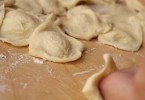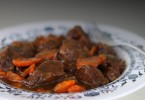Carciofi alla Giudia, history and culture in a dish
Carciofi alla Giudia, famous and well appreciated all over Italy, is one of the most tasty dishes of our culinary tradition, who knows the origin and the history of this dish?
The characteristic way of frying these artichokes has ancient origins and was born in the kitchens of the Capital; it makes part of the gastronomic heritage of Lazio even if it is different from the ancient Jewish-Roman tradition.
The culinary tradition of Rome and its ghetto
The culinary tradition of Rome has been enriched, during the centuries, of influences and contamination, remaining at the same time strictly tied to the peasant tradition and the characteristics of the city. For instance the traditional cuisine has developed different recipes that uses the less important parts of the animals: tripe, tail, intestine as a consequence of the big slaughterhouse situated in the quarter of Testaccio, where the cheapest meats fed the poorest classes. The typical roman recipes, like Coda alla Vaccinara o Pajata di agnello were born in this way. In fact, the city had deep roots in the peasant culture around the urban area and the roman tables were full of legumes, in particular chickpeas and grains but also chicory and puntarelle. A strong influence has arrived, at the end, from the Jewish cuisine of the roman ghetto that introduced delicious dishes in the local gastronomy like the anchovies and endive pie and the famous Giudia artichokes.
Carciofi alla Giudia, the ancient Jewish recipe
The original recipe was born in the Jewish ghetto of the city and is often mentioned in the recipe books of the XVI century. The Jewish cuisine of Ghetto was rich and refined, it is made of proposals of excellent confectionery like ricotta pie or dried biscuits, or the tasty fry food like courgette flowers with mozzarella and anchovies, codfish or artichokes.
Carciofi alla Giudia: the origin of its name
The whole fried artichokes that characterise this recipe are defined “alla Giudia” by the popular tradition because they are associated to a special occasion where the Jewish believers ate these fried delicious. It was used, in fact, to celebrate eating fried artichokes at the end of the Kippur day that require to fast, without working or toiling, for 24 hours. At the end of Kippur the Jewish families ate delicious dishes, and also these artichokes.
The real recipe of Carciofi alla Giudia
The most important thing to do, to prepare the real recipe, is to buy the so-called “mammole”, the artichokes of Lazio, round, soft, delicate and without thorns that can be eaten as a whole without leftovers. The recipe is ready in few simple steps: press the artichokes in order to open the leaves, season them and dive them into hot oil for ten minutes. The secret is to make a second dive in hot oil: the leaves will open completely and will become really crispy. The only thing to do is to salt and eat them really hot.









